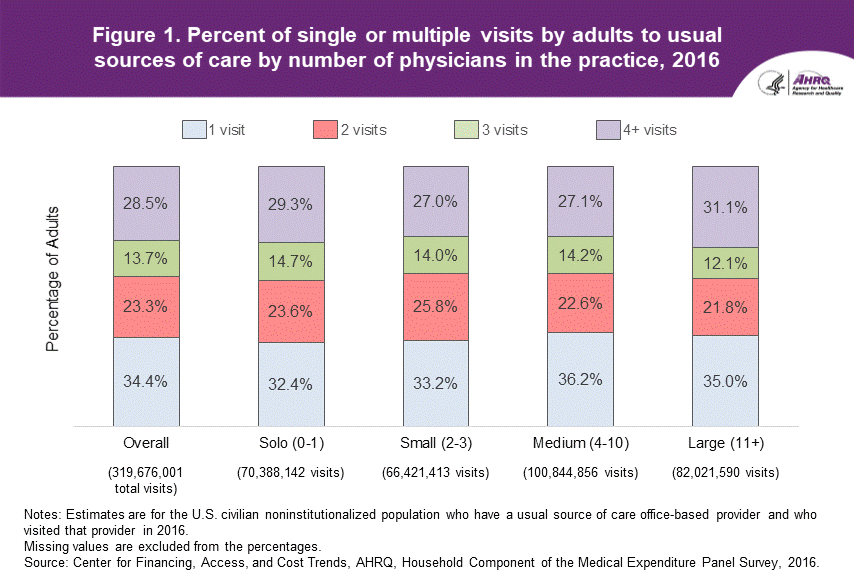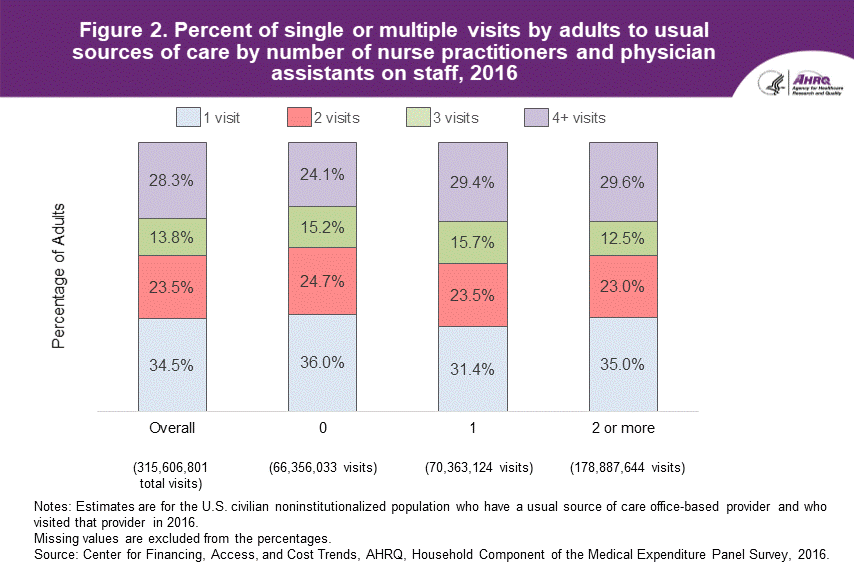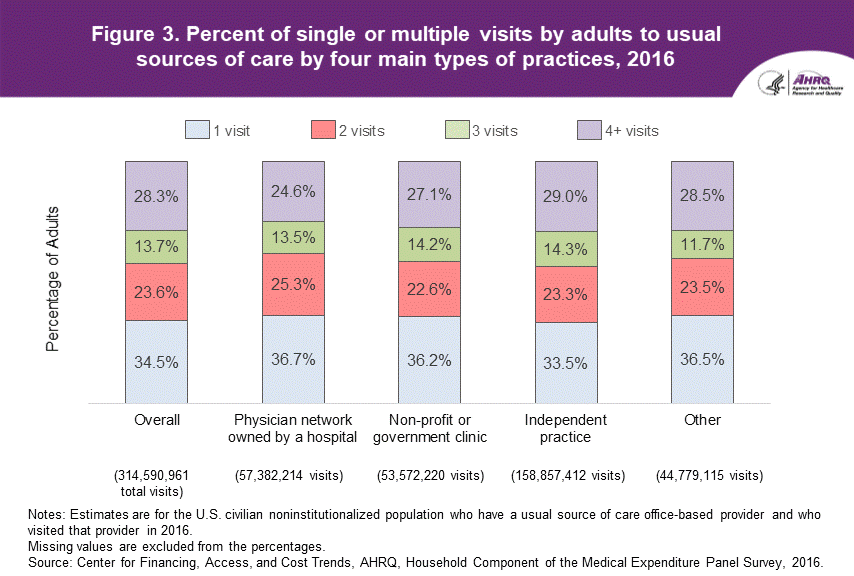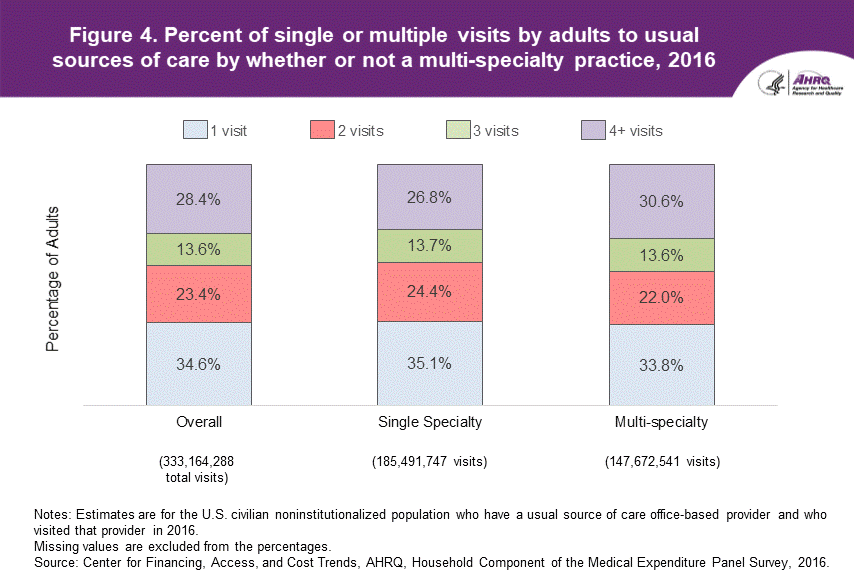STATISTICAL BRIEF #523:
|
|||||||||||||||||||||||||||||||||||||
| July 2019 | |||||||||||||||||||||||||||||||||||||
|
Monica L. Wolford, MA and Marie N. Stagnitti, MPA |
|||||||||||||||||||||||||||||||||||||
Highlights
|
|||||||||||||||||||||||||||||||||||||
IntroductionThe U.S. office-based physician market has experienced substantial changes in recent years. A growing number of office-based physicians are practicing in large group practices, and vertical integration between hospitals and physician group practices through ownership and contractual relationships has accelerated1. Understanding how the organizational characteristics of office-based physicians interact with use of care is important to informing policymakers in their efforts to promote efficient healthcare delivery. The association between the number of visits adults make to their USCs and the characteristics of the practices they use may enhance our knowledge of how trends in organizational characteristics impact healthcare utilization.The Agency for Healthcare Research and Quality's (AHRQ) Medical Expenditure Panel Survey (MEPS) supplemental Medical Organizations Survey (MOS) is designed to provide nationally representative estimates of the characteristics of patients' usual sources of care (USCs) and to support analyses of the association between practice characteristics and patients' experiences with care, including access to care, service use, quality of care, and expenditures. This is the first Federal survey that has the capability of directly linking practice characteristics with patients' experiences. The MEPS MOS was funded in part by support from the Robert Wood Johnson Foundation, and the data were collected for calendar years 2015 and 2016. The MEPS MOS expands the current Medical Provider Component (MPC) to include information on characteristics of the practices of office-based providers identified by MEPS household respondents as their USC. Research domains included in the MOS survey instrument include practice ownership and size, provider mix, financial incentives, patient mix, access, quality, coordination of care, and use of electronic health/medical record systems. To be eligible for the MOS, a medical provider had to be 1) identified as an office-based USC for a MEPS respondent and 2) seen by the respondent during 2016. In 2016, an estimated 76 percent of the U.S. civilian noninstitutionalized population 18 years of age or older, about 183.7 million people, had a USC, and of those persons, about 61.6 percent (113.2 million people) saw their USC at least once during the year. The MOS sample was further limited to practices that were office-based (representing about 95 percent of the people who saw their USC, or the USC practices associated with 107.3 million adults) (data not shown). Under these criteria, estimates presented in this Statistical Brief reflect the characteristics of people in the U.S. civilian noninstitutionalized population who had a USC that was a physician in an office-based setting and who visited that USC in 2016 (hereafter referred to as “adults with a USC” or “USC adults”). Note that visits to office-based physicians are influenced by factors such as patient health, age, sex, and insurance status. This Statistical Brief does not make any adjustments for person characteristics that may be correlated with the number of adult visits. Only differences that are statistically significant at the .05 level or better are discussed in the Statistical Brief. |
|||||||||||||||||||||||||||||||||||||
FindingsClinical staff—sizes and typesOverall, adults averaged 3.2 visits to their office-based USC provider during 2016 (data not shown). A higher percentage of USC adults with four or more visits went to a USC that was a large practice (31.1 percent) compared to 27.0 percent and 27.1 percent, respectively, for adults whose USC was a small or medium-sized practice (figure 1). USC adults visiting a large practice had a higher mean number of visits (3.4) than USC adults visiting solo (3.2 visits) or small (2.9 visits) practices (data not shown). A higher percentage of adults with USCs that had no nurse practitioners or physician assistants on staff had just one visit (36.0 percent) during the year (figure 2) than did adults with USCs that had one nurse practitioner or physician assistant on staff (31.4 percent). A higher percentage of adults and whose USC had one nurse practitioners or physician assistants on staff (29.4 percent) or two or more on staff (29.6 percent) had four or more visits compared with those whose USC did not have these types of practitioners on staff (24.1 percent). Practice attributesA lower percentage of adults with a USC that is part of a physician network owned by a hospital made four or more visits (24.6 percent) during the year (figure 3) than did adults whose USC was an independent practice (29.0 percent). USC adults with a provider owned by a hospital had a lower mean number of visits (2.8 visits) than USC adults with non-profit/government clinics (3.9 visits), independent practices (3.1 visits), or other types of practices (3.1 visits) (data not shown). Approximately 30.6 percent of adults with a USC that was a multi-specialty practice had four or more visits to their USC, compared to 26.8 percent of adults that went to a USC that was a single specialty practice (figure 4). |
|||||||||||||||||||||||||||||||||||||
Data SourceThe estimates shown in this Statistical Brief are based on data from the MEPS HC-187 2016 Full Year Medical Organizations Survey File and the MEPS HC-192 2016 Full Year Consolidated Data File. |
|||||||||||||||||||||||||||||||||||||
DefinitionsMEPS Medical Organizations SurveyThe 2016 MOS is an expansion of the MPC data collection, and collects data on the organization of the practices of office-based care providers identified as a USC in the MEPS Household Component (HC) that were seen by an HC-sampled person in 2016. This additional data collection is for a subset of office-based care providers already included in the MEPS MPC sample. In the MEPS MPC sample, primary locations for individuals' office-based USCs were identified. The MEPS MPC contacted these places where medical care was provided to determine the appropriate respondent and administer an MEPS MOS. The design of the survey is multi-modal, including phone, fax, mail, self-administration, electronic transmission, and secure email. The data collection method chosen for a provider was the method that resulted in the most complete and accurate data with minimal burden to the respondent. Usual Source of Care For each individual family member, MEPS ascertains whether there is a particular doctor's office, clinic, health center, or other place that the respondent usually visits if he/she is sick or needs advice about his/her health. For the MEPS MOS, the USC can be reported as an individual, an individual in a group practice, or as a practice; however, note that the MOS survey respondent is asked to answer the questions at the practice level. MEPS MOS Sample Frame The 2016 MOS was fielded in 2017 but is linked to data collected for the 2016 MEPS. Data are for persons that had a visit to their USC provider in 2016, and the USC question was asked in Panel 20 Round 4 and Panel 21 Round 2. Only persons who saw their office-based USC provider were included in the sample frame. The sum of the MOS weights across sample persons in this file is 146,948,373, which represents the estimated number of persons in the U.S. civilian noninstitutionalized population who had one or more visits to their office-based USC provider in 2016. This estimate assumes that the 1.9 percent of persons with missing data for the USC question did not visit an office-based USC provider during the year. Adults Adults were defined as persons age 18 and older. The age variable used to identify adults is based on the sample person's age as of the end of the year. If data were not collected during a round because the sample person was out of scope (e.g., deceased or institutionalized), then age at the time of the previous round was used. |
|||||||||||||||||||||||||||||||||||||
About MEPS-HCThe Medical Expenditure Panel Survey Household Component (MEPS-HC) collects nationally representative data on healthcare use, expenditures, sources of payment, and insurance coverage for the U.S. civilian noninstitutionalized population. The MEPS-HC is cosponsored by the Agency for Healthcare Research and Quality (AHRQ) and the National Center for Health Statistics (NCHS). More information about the MEPS-HC can be found on the MEPS website at https://meps.ahrq.gov/. |
|||||||||||||||||||||||||||||||||||||
ReferencesFor a detailed description of the MEPS-HC survey design, sample design, and methods used to minimize sources of nonsampling error, see the following publications:Cohen, J. Design and Methods of the Medical Expenditure Panel Survey Household Component. MEPS Methodology Report No. 1. AHCPR Pub. No. 97-0026. Rockville, MD. Agency for Healthcare Policy and Research, 1997. https://meps.ahrq.gov/data_files/publications/mr1/mr1.shtml Cohen, S. Sample Design of the 1996 Medical Expenditure Panel Survey Household Component. MEPS Methodology Report No. 2. AHCPR Pub. No. 97-0027. Rockville, MD. Agency for Healthcare Policy and Research, 1997. https://meps.ahrq.gov/data_files/publications/mr2/mr2.shtml Cohen, S. Design Strategies and Innovations in the Medical Expenditure Panel Survey. Medical Care, July 2003: 41(7) Supplement: III-5–III-12. Cohen, S. B., Cohen, J.W., Stagnitti, M.N., Lefkowitz, D.C. Implementation of a Linked Medical Organization Survey in the Medical Expenditure Panel Survey. Journal of Economic and Social Measurement, February 2017: 41(4): 417-432. Ezzati-Rice, T.M., Rohde, F., Greenblatt, J. Sample Design of the Medical Expenditure Panel Survey Household Component, 1998-2007. Methodology Report No. 22. March 2008. Agency for Healthcare Research and Quality, Rockville, MD. https://meps.ahrq.gov/data_files/publications/mr22/mr22.shtml Soni, A. and Stagnitti, M.N. Characteristics of Practices Used as Usual Source of Care Providers during 2015, by Age—Results from the MEPS Medical Organizations Survey. Statistical Brief #509. March 2018. Agency for Healthcare Research and Quality, Rockville, MD. https://meps.ahrq.gov/data_files/publications/st509/stat509.shtml Stagnitti, M. N., Beauregard, K., and Solis, A. Design, Methods, and Field Results of the Medical Expenditure Panel Survey Medical Provider Component (MEPS MPC)—2006 Calendar Year Data. Methodology Report No. 23. November 2008. Agency for Healthcare Research and Quality, Rockville, MD. https://meps.ahrq.gov/data_files/publications/mr23/mr23.shtml Stagnitti, M.N., Moriya, A., Soni, A., Wolford, M., Zodet, M. Characteristics of Practices Used as Usual Source of Care Providers during 2015—Results from the MEPS Medical Organizations Survey. Statistical Brief #502. April 2017. Agency for Healthcare Research and Quality, Rockville, MD. https://meps.ahrq.gov/data_files/publications/st502/stat502.shtml Zodet, M., S. Chowdhury, S. Machlin, and J. Cohen. 2016. Linked designs of the MEPS Medical Provider and Organization Surveys. In JSM Proceedings, Survey Research Methods Section. Alexandria, VA: American Statistical Association. 1914-1921. |
|||||||||||||||||||||||||||||||||||||
Suggested CitationWolford, M.L. and Stagnitti, M.N. Number of Adult Visits by Characteristics of Practices Identified as Usual Source of Care Providers during 2016–Results from the MEPS Medical Organizations Survey. Statistical Brief #523. July 2019. Agency for Healthcare Research and Quality, Rockville, MD. https://meps.ahrq.gov/data_files/publications/st523/stat523.shtml |
|||||||||||||||||||||||||||||||||||||
|
AHRQ welcomes questions and comments from readers of this publication who are interested in obtaining more information about access, cost, use, financing, and quality of healthcare in the United States. We also invite you to tell us how you are using this Statistical Brief and other MEPS data and tools and to share suggestions on how MEPS products might be enhanced to further meet your needs. Please email us at MEPSProjectDirector@ahrq.hhs.gov or send a letter to the address below: Joel W. Cohen, PhD, Director Center for Financing, Access, and Cost Trends Agency for Healthcare Research and Quality 5600 Fishers Lane, Mailstop 07W41A Rockville, MD 20857 |
|||||||||||||||||||||||||||||||||||||
|
1Burns, L. R., Goldsmith J.C., and Sen, A. "Horizontal and Vertical Integration of Physicians: a Tale of Two Tails." Annual Review of Health Care Management: Revisiting the Evolution of Health Systems Organization. Emerald Group Publishing Limited, 2014. 39-117. |
|||||||||||||||||||||||||||||||||||||
 |
|||||||||||||||||||||||||||||||||||||
|
|||||||||||||||||||||||||||||||||||||
 |
|||||||||||||||||||||||||||||||||||||
|
|||||||||||||||||||||||||||||||||||||
 |
|||||||||||||||||||||||||||||||||||||
|
|||||||||||||||||||||||||||||||||||||
 |
|||||||||||||||||||||||||||||||||||||
|

|
|
Font Size:
|
||||
|
|
|
|
||||


